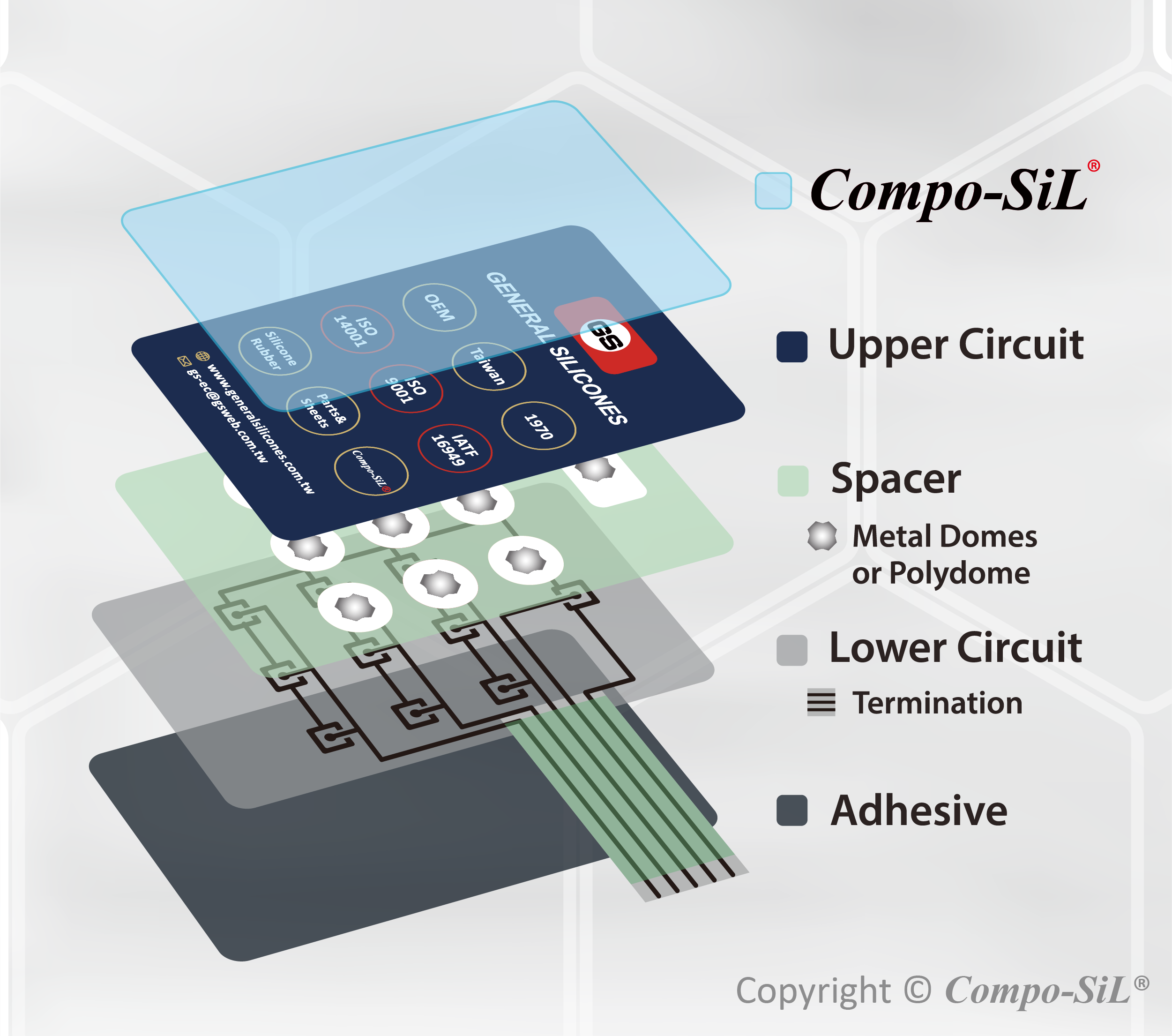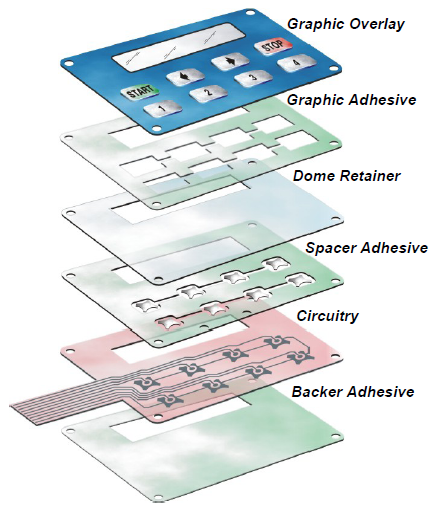All About Membrane Switch: A Comprehensive Guide for Beginners
Membrane layer switches are vital elements in contemporary electronics, supplying an unique interface for user interaction - membrane switch. Their layered building and construction, consisting of overlays and conductive traces, provides performance and toughness. Unlike conventional mechanical buttons, membrane layer switches offer a smooth layout and personalized choices. Recognizing their essential functions and benefits can change product design. The ins and outs of their application and design considerations warrant additional exploration.
What Is a Membrane Change?
A membrane layer switch is a type of electrical button that consists of an adaptable membrane layered over a printed motherboard. This layout allows for a sleek and small interface, frequently used in various electronic tools. Membrane layer switches are commonly located in consumer appliances, clinical tools, and industrial machinery as a result of their toughness and resistance to ecological factors.The building and construction typically consists of numerous layers, such as visuals overlays and adhesive backing, which provide tactile comments and secure the wiring below. The operation of a membrane layer button is started when pressure is related to the surface, completing an electrical circuit.These buttons are valued for their flexibility, allowing custom layouts and published graphics that accommodate specific user interfaces. Their inconspicuous nature decreases space requirements, making them perfect for applications where conventional switches may not fit. Generally, membrane layer buttons use a aesthetic and functional option for contemporary electronic gadgets.
Key Elements of Membrane Layer Switches
Membrane switches over consist of a number of vital parts that add to their capability and efficiency. The top layer, called the overlay, supplies the interface and is often printed with icons or graphics. Under the overlay exists a spacer layer, which separates the conductive aspects and protects against unintentional activation. The next vital component is the graphic layer, which boosts aesthetic appeals and guarantees the toughness of the design.Conductive traces, typically made from materials like silver or carbon, are printed on the circuit layer. When stress is related to the overlay, these traces enter into call, completing the circuit. Additionally, a backing layer provides structural support and can be made from materials such as polyester or polycarbonate. Together, these elements develop a reliable, user-friendly user interface appropriate for different applications, from house home appliances to industrial equipment. Comprehending these components is important for any individual curious about membrane layer button technology.
Exactly How Membrane Changes Job
Comprehending just how membrane layer switches over function is necessary for appreciating their extensive use in different tools. A membrane layer switch runs via a series of layers, consisting of a graphic overlay, spacer, and a circuit layer. When stress is put on the overlay, it presses the spacer layer, enabling the circuit layer to make contact and complete an electric circuit. This activity sends a signal to the device, motivating an action, such as transforming on a light or activating a function.Membrane switches can be created with numerous functions, including tactile responses, backlighting, and customized graphics, improving user interaction. Their building permits a sealed layout, protecting the internal elements from dirt, moisture, and pollutants. This toughness makes them appropriate for varied applications, from consumer electronics to commercial devices. On the whole, the simplicity and effectiveness of membrane layer switches contribute to their popularity in modern innovation.
Benefits of Membrane Layer Switches Mechanical Buttons
While mechanical buttons have actually long been a staple in many devices, membrane layer switches deal distinct benefits that make them progressively appealing. One considerable advantage is their slim account, permitting more portable styles and greater flexibility in product advancement. Additionally, membrane layer switches feature an uniform surface area, which improves visual charm and simplifies cleaning, making them appropriate for environments where health is critical.Another advantage is their resistance to dust and wetness. Unlike mechanical buttons, which can be compromised by ecological factors, membrane layer switches provide a covered user interface that secures versus pollutants - membrane switch. Furthermore, membrane layer buttons typically have a longer life-span due to less moving parts, leading to improved resilience and reliability.Cost-effectiveness is likewise a notable benefit, as membrane switches can be produced in mass with reduced manufacturing prices. These factors incorporate to place membrane switches as a sensible choice to standard mechanical choices in numerous applications
Common Applications of Membrane Switches Over
Membrane buttons are extensively utilized in numerous sectors, particularly in consumer electronic devices and industrial control panels. In consumer gadgets, they give a streamlined, easy to use interface, while in industrial settings, they enhance sturdiness and functionality. Recognizing these applications highlights the adaptability and usefulness of membrane layer buttons in modern innovation.
Consumer Electronic Devices Devices
As customer electronics remain to evolve, membrane switches have actually ended up being a prominent option for a selection of gadgets because of their flexibility and smooth layout. These buttons are commonly located in smartphones, tablets, and remotes, where room is limited and aesthetics issue. Their reduced account and customizable layouts enable makers to develop straightforward user interfaces that boost the total customer experience. Furthermore, membrane switches are often used in appliances such as microwaves and coffee machine, giving instinctive control choices while withstanding moisture and dust. The longevity and integrity of membrane layer changes make them suitable for day-to-day customer items, making sure long life and constant performance. On the whole, their assimilation in consumer electronic devices mirrors a blend of capability and contemporary design.
Industrial Control Panels
The applications of membrane layer changes extend past consumer electronics, discovering significant usage in industrial control board. These switches are favored for their longevity and resistance to extreme atmospheres, making them ideal for making and process control setups. They provide a reliable user interface for operators to regulate machinery, display processes, and readjust settings. Membrane layer switches can be personalized to suit certain functional requirements, including functions like backlighting and responsive comments, boosting user experience. Their inconspicuous design enables for assimilation into numerous tools, while their capacity to stand up to spills, dust, and extreme temperature Learn More levels assurances longevity. Generally, membrane layer switches add to safe and effective procedure in commercial applications, demonstrating their adaptability and performance in demanding settings.
Considerations for Creating Membrane Layer Switches
When designing membrane switches, picking the best products is vital to ensure durability and performance. Furthermore, recognizing layer arrangement strategies can greatly affect the switch's efficiency and user experience. These considerations play an essential function in producing trusted and reliable membrane layer button styles.
Product Choice Value
Material selection plays a vital function in the style and performance of membrane switches. The chosen products straight impact the switch's resilience, tactile response, and overall visual. Secret considerations include the substratum, which have to give architectural stability while enabling flexibility, and the visuals overlay, which requires to be resistant to wear and ecological aspects. Conductive materials ought to guarantee trusted electric performance, while adhesives should offer solid bonding without jeopardizing the switch's operation. In addition, compatibility with producing procedures and end-user atmospheres is crucial; products should withstand differing temperatures, moisture levels, and chemical direct exposure. Eventually, appropriate product selection not just enhances the membrane layer switch's efficiency but additionally adds to its long life and individual fulfillment, making it a crucial facet of the style procedure.

Layer Configuration Methods

Regularly Asked Concerns
The Length Of Time Do Membrane Switches Over Typically Last?
Membrane buttons normally have a lifespan of 1 to 5 million cycles, depending upon use and environmental conditions. Elements such as layout top quality and operating regularity greatly affect their resilience and general efficiency longevity.

Can Membrane Switches Be Custom-made for Certain Styles?
Membrane buttons can without a doubt be personalized to fit specific layouts, permitting for diverse shapes, shades, and performances. This flexibility enables suppliers to tailor these switches to fulfill distinct aesthetic and functional demands efficiently.
What Products Are Utilized in Membrane Change Construction?
Membrane layer buttons are normally constructed utilizing products such as polyester, polycarbonate, and adhesive layers. These products give versatility, resistance, and longevity to ecological variables, ensuring the switches work properly in various applications and conditions.
Are Membrane Layer Switches Over Water Resistant or Resistant to Wetness?
Membrane layer buttons can be designed to be moisture-resistant, utilizing specialized finishes and products. Their waterproof capabilities depend on construction quality and particular applications, making it essential to analyze requirements for ideal efficiency in different environments.
Exactly How Are Membrane Layer Changes Fixed if Harmed?
Fixing damaged membrane switches over normally entails replacing the affected layer or circuit. Technicians may also apply conductive sticky or make use of specialized repair packages, making certain capability is brought back without complete replacement of the whole switch assembly. Unlike typical mechanical buttons, membrane buttons provide a smooth layout and personalized choices. A membrane button is a type of electrical button that consists of an adaptable membrane layered over a published circuit board. The operation about his of a membrane button is initiated when stress is applied to the surface area, completing an electrical circuit.These buttons are valued for their flexibility, enabling custom-made designs and published graphics that cater to specific individual interfaces. While mechanical switches have actually long been a staple in many gadgets, membrane changes offer unique benefits that make them progressively appealing. Membrane layer switches generally have a longer life-span due to fewer relocating components, resulting in improved durability and reliability.Cost-effectiveness is likewise a notable benefit, as membrane buttons can be produced in mass with reduced production expenses.